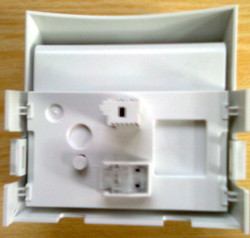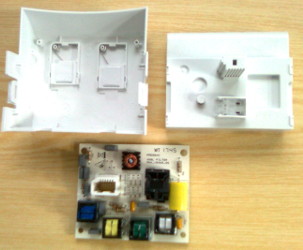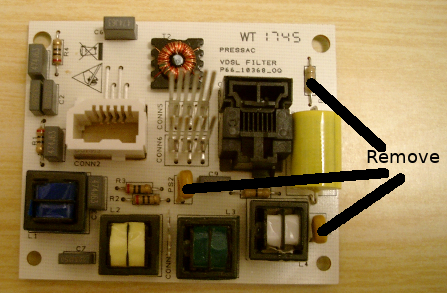VoIP How to: Voice reinjection: Difference between revisions
Describe what to remove |
Reassemble and use |
||
| Line 40: | Line 40: | ||
* Two components need to be removed, and it's recommended to remove a third one. The components to remove are labelled PS1 and PS2 on the circuit board - they may be orange in colour, and can be removed by unsoldering or mechanical destruction. It's optional to remove the resistor labelled R6, the VDSL SSFP doesn't use the bell capacitor in the NTE5c - it provides its own bell capacitor (labelled C8). R6 connects the bell capacitor to the telephone socket, but we're now using the telephone socket as an input from the ATA and so R6 isn't needed and might cause confusion. |
* Two components need to be removed, and it's recommended to remove a third one. The components to remove are labelled PS1 and PS2 on the circuit board - they may be orange in colour, and can be removed by unsoldering or mechanical destruction. It's optional to remove the resistor labelled R6, the VDSL SSFP doesn't use the bell capacitor in the NTE5c - it provides its own bell capacitor (labelled C8). R6 connects the bell capacitor to the telephone socket, but we're now using the telephone socket as an input from the ATA and so R6 isn't needed and might cause confusion. |
||
[[ File: VDSL_SSFP_pcb.jpg |
[[ File: VDSL_SSFP_pcb.jpg]] |
||
One can now simply connect the ATA phone socket to the phone socket on the VDSL SSFP with an RJ11 plug to BT phone plug lead. It doesn't need to provide a bell capacitor. A lead from an old modem (pre broadband) may be ideal. |
Reassemble the VDSL SSFP and install it on the NTE5c. One can now simply connect the ATA phone socket to the phone socket on the VDSL SSFP with an RJ11 plug to BT phone plug lead. It doesn't need to provide a bell capacitor. A lead from an old modem (pre broadband) may be ideal. |
||
[[Category:VoIP How to]] |
[[Category:VoIP How to]] |
||
Revision as of 22:14, 3 October 2018
In BT terminology, Voice Reinjection is the way to route voice signals from a VoIP service onto the existing home telephone wiring. This will become more common as copper pairs are replaced by optical fibre.
In the meantime, if you have a copper pair from A&A (i.e. without telephone service on that copper pair) and use VoIP, you may want to route the voice signals from VoIP onto the existing home telephone wiring.
This page gives some ideas of how this can be achieved without installing extra phone sockets.
NTE5c and VDSL Service Specific FacePlate
A modern Openreach installation will terminate the copper pair on an NTE5c master socket which will have a VDSL SSFP clipped to the front of it.
The VDSL SSFP provides two sockets - an RJ45 to connect to the modem/router, and a telephone socket for a local handset. The VDSL SSFP also feeds the voice signals to the home telephone wiring via the NTE5c.
If one plugs an Analogue Telephone Adaptor into the router via Ethernet, then the ATA provides the voice signals on an RJ11 socket. This is fine to connect, using an RJ11 plug to phone plug lead (with ringing capacitor), to a local handset - but fails to connect to the home telephone wiring.
One can connect the ATA voice signals to the home telephone wiring, but it means some modifications to the VDSL SSFP. It's probably a good idea to buy a spare VDSL SSFP, so one can revert to a standard setup easily.
Modifying the VDSL SSFP
These modifications need some degree of technical know-how, and you might need to consult someone if you feel you don't have that know-how.
- Gently unclip the 4 plastic clips which retain the inner white plastic part of the VDSL SSFP from the outer shell, and lift the inner part out. Try to pull straight, as the metal pins of the telephone plug are attached to the circuit board and could be damaged if handled roughly
- Gently unclip the 4 plastic clips which retain the circuit board in the outer shell, and lift out the circuit board.
You should now have gone from
 to
to

- Two components need to be removed, and it's recommended to remove a third one. The components to remove are labelled PS1 and PS2 on the circuit board - they may be orange in colour, and can be removed by unsoldering or mechanical destruction. It's optional to remove the resistor labelled R6, the VDSL SSFP doesn't use the bell capacitor in the NTE5c - it provides its own bell capacitor (labelled C8). R6 connects the bell capacitor to the telephone socket, but we're now using the telephone socket as an input from the ATA and so R6 isn't needed and might cause confusion.
Reassemble the VDSL SSFP and install it on the NTE5c. One can now simply connect the ATA phone socket to the phone socket on the VDSL SSFP with an RJ11 plug to BT phone plug lead. It doesn't need to provide a bell capacitor. A lead from an old modem (pre broadband) may be ideal.
